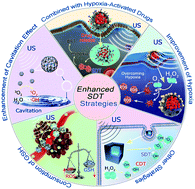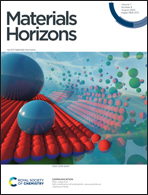Newly developed strategies for improving sonodynamic therapy
Abstract
Sonodynamic therapy (SDT) is a new therapeutic method, which can kill malignant tumors by using sonosensitizers and low intensity ultrasound (US) simultaneously. Compared with photo-triggered therapy, SDT exhibits lots of benefits and merits, including high accuracy, deeper tissue penetration, good patient compliance, and fewer side effects. US can penetrate the deep tissues and focus on the tumor areas, thereby activating sonosensitizers, which offers the possibility of non-invasively eradicating solid tumors in a targeted manner. However, the hypoxic tumor microenvironment (TME) and the low quantum yield of sonosensitizers limit the treatment efficiency of SDT. Therefore, it is crucial to improve the sonodynamic effect. In this minireview, we briefly introduce the possible mechanisms of SDT, including the production of reactive oxygen species (ROS), cavitation effect, and hyperthermia destruction. Then we summarize various newly developed strategies to improve the efficacy of SDT through the use of sonosensitizers based on the mechanisms of SDT, providing a theoretical basis for the development of SDT in the future. The strategies to improve the therapeutic efficiency of SDT mainly include: (1) improvement of hypoxia; (2) enhancement of the cavitation effect; (3) consumption of reducing substances (e.g., glutathione, GSH); (4) combination with hypoxia-activated chemotherapeutic drugs; and (5) combination with immunotherapy. In addition, we also focus on the potential strategies of combining SDT with other therapies, and discuss the challenges and limitations of SDT in future clinical applications.

- This article is part of the themed collection: Recent Review Articles


 Please wait while we load your content...
Please wait while we load your content...